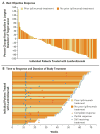Safety and tumor responses with lambrolizumab (anti-PD-1) in melanoma
- PMID: 23724846
- PMCID: PMC4126516
- DOI: 10.1056/NEJMoa1305133
Safety and tumor responses with lambrolizumab (anti-PD-1) in melanoma
Erratum in
-
Neoadjuvant PD-1 Blockade in Resectable Lung Cancer; Nivolumab and Ipilimumab in Advanced Melanoma; Overall Survival with Combined Nivolumab and Ipilimumab in Advanced Melanoma; Prolonged Survival in Stage III Melanoma with Ipilimumab Adjuvant Therapy; Combined Nivolumab and Ipilimumab or Monotherapy in Untreated Melanoma; Combined Nivolumab and Ipilimumab or Monotherapy in Untreated Melanoma; Nivolumab and Ipilimumab versus Ipilimumab in Untreated Melanoma; Rapid Eradication of a Bulky Melanoma Mass with One Dose of Immunotherapy; Genetic Basis for Clinical Response to CTLA-4 Blockade; Genetic Basis for Clinical Response to CTLA-4 Blockade in Melanoma; Nivolumab plus Ipilimumab in Advanced Melanoma; Safety and Tumor Responses with Lambrolizumab (Anti-PD-1) in Melanoma; Hepatotoxicity with Combination of Vemurafenib and Ipilimumab.N Engl J Med. 2018 Nov 29;379(22):2185. doi: 10.1056/NEJMx180040. Epub 2018 Nov 9. N Engl J Med. 2018. PMID: 31442371 No abstract available.
Abstract
Background: The programmed death 1 (PD-1) receptor is a negative regulator of T-cell effector mechanisms that limits immune responses against cancer. We tested the anti-PD-1 antibody lambrolizumab (previously known as MK-3475) in patients with advanced melanoma.
Methods: We administered lambrolizumab intravenously at a dose of 10 mg per kilogram of body weight every 2 or 3 weeks or 2 mg per kilogram every 3 weeks in patients with advanced melanoma, both those who had received prior treatment with the immune checkpoint inhibitor ipilimumab and those who had not. Tumor responses were assessed every 12 weeks.
Results: A total of 135 patients with advanced melanoma were treated. Common adverse events attributed to treatment were fatigue, rash, pruritus, and diarrhea; most of the adverse events were low grade. The confirmed response rate across all dose cohorts, evaluated by central radiologic review according to the Response Evaluation Criteria in Solid Tumors (RECIST), version 1.1, was 38% (95% confidence interval [CI], 25 to 44), with the highest confirmed response rate observed in the cohort that received 10 mg per kilogram every 2 weeks (52%; 95% CI, 38 to 66). The response rate did not differ significantly between patients who had received prior ipilimumab treatment and those who had not (confirmed response rate, 38% [95% CI, 23 to 55] and 37% [95% CI, 26 to 49], respectively). Responses were durable in the majority of patients (median follow-up, 11 months among patients who had a response); 81% of the patients who had a response (42 of 52) were still receiving treatment at the time of analysis in March 2013. The overall median progression-free survival among the 135 patients was longer than 7 months.
Conclusions: In patients with advanced melanoma, including those who had had disease progression while they had been receiving ipilimumab, treatment with lambrolizumab resulted in a high rate of sustained tumor regression, with mainly grade 1 or 2 toxic effects. (Funded by Merck Sharp and Dohme; ClinicalTrials.gov number, NCT01295827.).
Figures


Comment in
-
Combination checkpoint blockade--taking melanoma immunotherapy to the next level.N Engl J Med. 2013 Jul 11;369(2):187-9. doi: 10.1056/NEJMe1305484. Epub 2013 Jun 2. N Engl J Med. 2013. PMID: 23724866 No abstract available.
-
From ASCO-targeted therapies: Anti-PD-1 approaches--important steps forward in metastatic melanoma.Nat Rev Clin Oncol. 2013 Jul;10(7):365. doi: 10.1038/nrclinonc.2013.98. Epub 2013 Jun 11. Nat Rev Clin Oncol. 2013. PMID: 23752732 No abstract available.
References
-
- Robert C, Thomas L, Bondarenko I, et al. Ipilimumab plus dacarbazine for previously untreated metastatic melanoma. N Engl J Med. 2011;364:2517–26. - PubMed
-
- Blank C, Brown I, Peterson AC, et al. PD-L1/B7H-1 inhibits the effector phase of tumor rejection by T cell receptor (TCR) transgenic CD8+ T cells. Cancer Res. 2004;64:1140–5. - PubMed
-
- Okazaki T, Honjo T. PD-1 and PD-1 ligands: from discovery to clinical application. Int Immunol. 2007;19:813–24. - PubMed
Publication types
MeSH terms
Substances
Associated data
Grants and funding
LinkOut - more resources
Full Text Sources
Other Literature Sources
Medical
